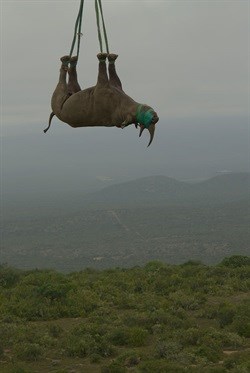
Subscribe & Follow
Advertise your job vacancies
Black rhinos relocated to undisclosed location
A group of 19 black rhino were recently translocated to an undisclosed location in South Africa.

The animals form the tenth population to be facilitated through WWF South Africa's Black Rhino Range Expansion Project (BRREP) and were made available through the Eastern Cape Parks and Tourism Agency. Growing rhino populations is part of WWF South Africa's five-point rhino plan.
Black rhino are more at risk of extinction than white rhino due to their low numbers. Since the start of the programme in 2003, BRREP has overseen the relocation of around 160 black rhino to form new breeding populations and more than 50 calves have been born on project sites.
"We are extremely proud of the Agency's contribution to the conservation of this species," said Vuyani Dayimani, CEO of Eastern Cape Parks and Tourism Agency. "By doing this the Agency is actively contributing to the achievement of the objectives of the National biodiversity management plan for black rhino in South Africa.
"One of the key objectives of this plan is to grow the national population as rapidly as possible by harvesting animals from populations that are at or near ecological carrying capacity and using these animals to create new populations. This harvesting stimulates growth in the donor population and also makes animals available for the creation of new populations," Dayimani said.
Commitment to conservation
"We are really grateful for Eastern Cape Parks and Tourism Agency's progressive approach to the conservation of black rhino," said Dr Jacques Flamand, head of the Black Rhino Range Expansion Project. "It requires a genuine commitment to conservation to entrust others with the care of such a large group of these precious animals, but this is for the greater good of the species. Establishing a new population is extremely exciting for us because this is essentially what the project works towards. To see our efforts come to fruition is very encouraging."
The Black Rhino Range Expansion Project aims to increase the numbers of black rhino by encouraging rapid population growth. It is a vital part of South Africa's drive to reach a target of 3,000 black rhino.
"South Africa now has significantly more black rhino than there would have been without the project's intervention. Founder populations released on to large areas of land have the potential to increase quickly in number. And moving rhinos from our major parks relieves pressure, allowing for more rapid growth both at source and in their new terrain," according to Dr Flamand.
The recent translocation involved WWF and Eastern Cape Parks and Tourism Agency with help from SANParks and Ezemvelo KZN Wildlife. Six wildlife veterinarians participated in the project which saw darted animals being airlifted by helicopter to a central loading area where they were loaded into crates and prepared for a road trip to their new home.








